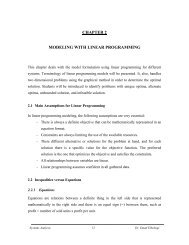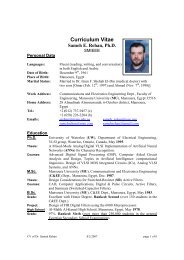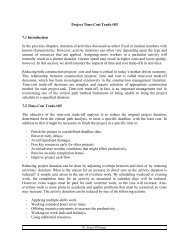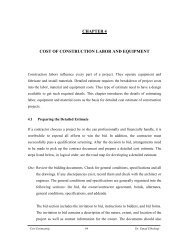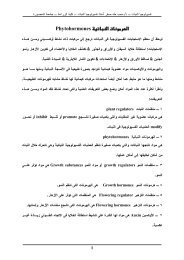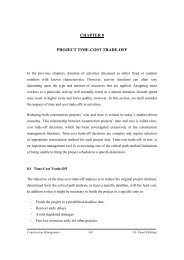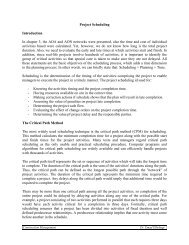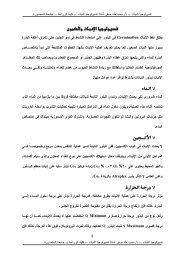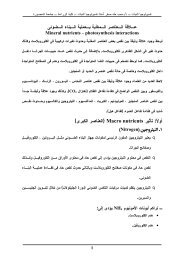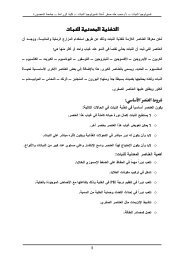Thyroid and Parathyroid
Thyroid and Parathyroid
Thyroid and Parathyroid
You also want an ePaper? Increase the reach of your titles
YUMPU automatically turns print PDFs into web optimized ePapers that Google loves.
ASSESSMENT OF PATIENTS WITH THYROID DISEASE<br />
<strong>Thyroid</strong> disease may be divided into two types: problems relating to function<br />
(hyperthyroidism/hypothyroidism) <strong>and</strong> thyroid masses. The two types are not<br />
. mutually exclusive <strong>and</strong> patients frequently present with both problems<br />
History<br />
Obtaining an accurate history is essential in assessing thyroid disease. Symptoms such<br />
as dysphagia, dyspnea, <strong>and</strong> choking are frequently encountered in patients with goiter<br />
<strong>and</strong> may be exaggerated by patients raising their arms above their heads (Pemberton's<br />
sign). Pain is uncommon. Localized pain may suggest malignancy, especially<br />
medullary thyroid cancer, whereas pain radiating to the ear often is observed in<br />
patients with thyroiditis or hemorrhage within the thyroid gl<strong>and</strong>. A change in the<br />
character of the voice should also be of concern because it may suggest involvement<br />
of the recurrent laryngeal nerves in a malignant process, with vocal cord paralysis. A<br />
past history of exposure to radiation, family history of benign or malignant thyroid<br />
disease, living in an iodine- deficient area, or ingestion of goitrogenic drugs also are<br />
. significant<br />
Physical Examination<br />
<strong>Thyroid</strong> masses rise on swallowing; most thyroid swellings are accurately discernible<br />
by observing the patient swallow. Failure to observe before palpating the thyroid<br />
gl<strong>and</strong> may lead to missing a large retrosternal goiter arising from beneath the sternum<br />
. <strong>and</strong> clavicles<br />
Palpation usually is performed from behind while the patient is sitting in a chair with<br />
the neck slightly extended <strong>and</strong> should include palpation of the gl<strong>and</strong> while the patient<br />
swallows. A l<strong>and</strong>mark is the cricoid cartilage; the isthmus almost always crosses a<br />
fingerbreadth below the cricoid. The normal thyroid gl<strong>and</strong> usually is not palpable<br />
unless the patient has a particularly thin neck. The thyroid gl<strong>and</strong> may be diffuse <strong>and</strong><br />
bilaterally enlarged (goiter), as encountered in conditions such as Graves' disease<br />
(hyperthyroidism), Hashimoto's thyroiditis, or multinodular goiter. A unilateral mass<br />
. may be palpated, as in a colloid nodule, follicular adenoma, or carcinoma<br />
The cervical chain of lymph nodes should be assessed as well as the nodes in the<br />
posterior triangle. The jugular nodes immediately adjacent to a thyroid nodule often<br />
are involved in patients with a papillary thyroid cancer. A Delphian node should be<br />
. palpated for just above the thyroid isthmus <strong>and</strong> cricoid cartilage<br />
Fine-Needle Aspiration Cytology (FNAC<br />
(<br />
Fine-needle aspiration cytology is a simple <strong>and</strong> low-risk technique that is an integral<br />
part of thyroid assessment in the outpatient setting for patients with thyroid nodules.<br />
A 23-gauge needle is inserted into the thyroid swelling, <strong>and</strong> several passes are made<br />
while aspirating the syringe. Cells are placed on prelabeled dry glass slides; some are<br />
then immediately placed in 70% alcohol while others are air dried. These slides are<br />
stained by Papanicolaou or Wright's stains <strong>and</strong> observed under the microscope.<br />
Skilled cytopathologists can accurately diagnose the majority of thyroid diseases<br />
using this technique, with a high degree of specificity. This test is less accurate in<br />
patients with thyroid nodules <strong>and</strong> a history of familial nonmedullary thyroid cancer<br />
<strong>and</strong> in patients with a previous history of exposure to low-dose therapeutic radiation.



